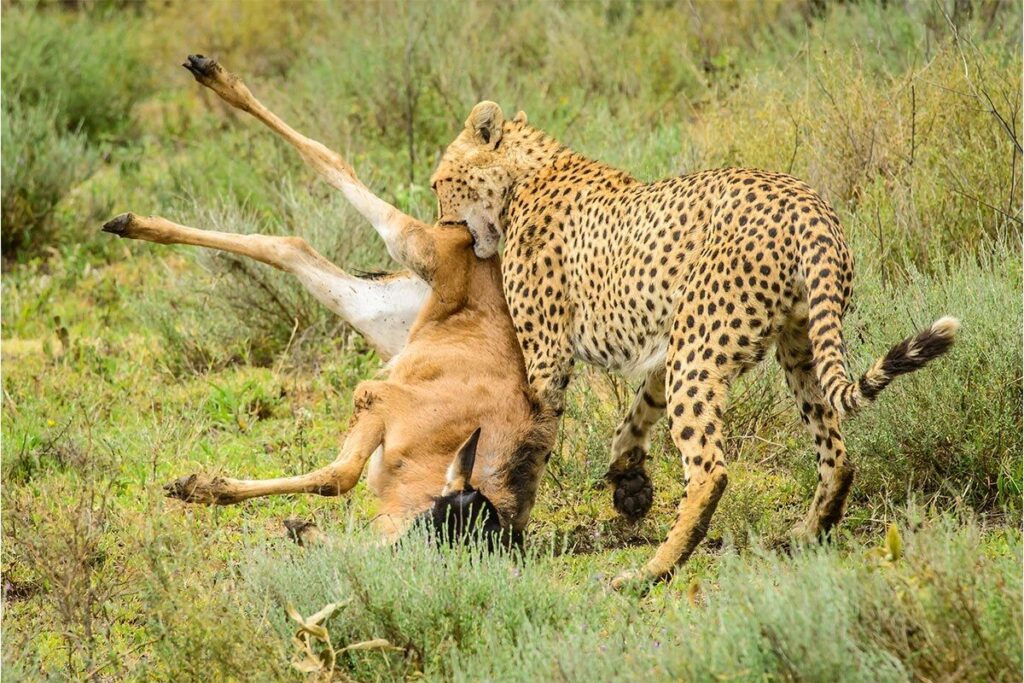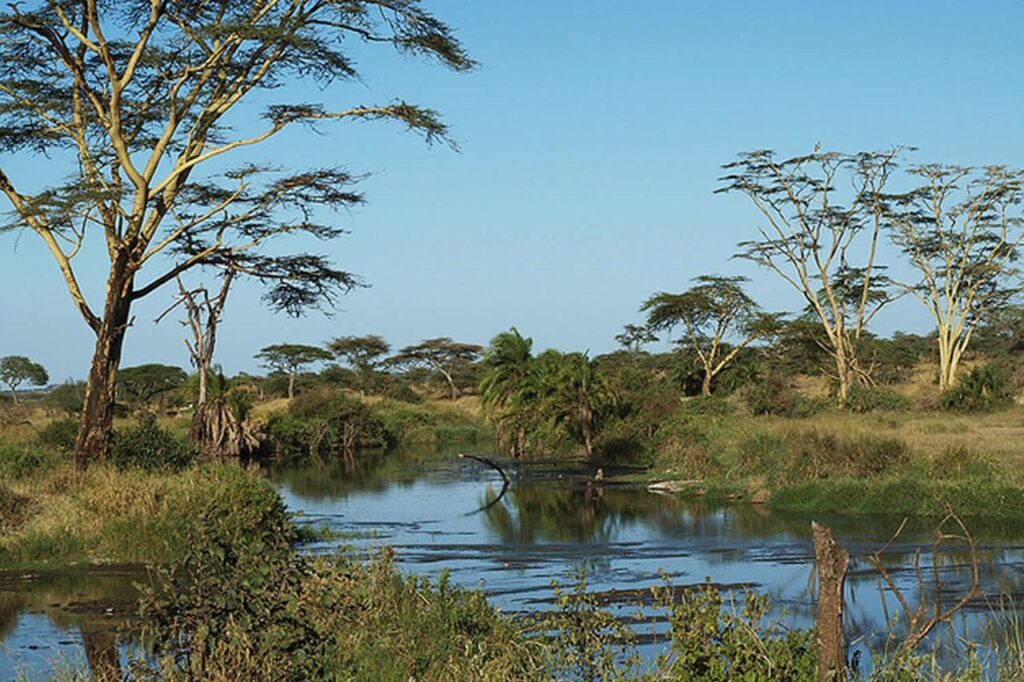Your trip to the Serengeti in Africa’s beloved Tanzania should go way beyond snapping photos of wildlife. In fact, your showreel will manage to capture great pictures throughout the year. Some of the common animals, some of the Big Five, some of the multitude of bird species, and most of the landscapes that cast a spell you’d love to be in. Yet, the rhythms of nature can make some months more disruptive than others.
Ideally, you want to choose the best time to visit the Serengeti. We’re talking about when the Serengeti shines as a torchbearer of wildlife events and nature’s forces in full force.
Remember that the Serengeti is a realm where each day opens a new chapter of wildlife activity in the eternal story of life, death, and survival on the African plains.
An Overview of Wildlife in The Serengeti
Located in the heart of northern Tanzania, the Serengeti stretches across 30,000 sq. kms of rolling grasslands and thriving ecosystems. This national park is where the earth beats with the wildlife of Tanzania, including the millions of hooves, wings, and paws.
This theatre of the wild hosts one of the planet’s most spectacular wildlife events, the Great Wildebeest Migration. A next-to-endless hoard of animals embarks on a long march of survival through grazing and killing in nature’s majesty. Roaring lions, stealthy leopards, elusive deers, and humble dik-diks—the animal kingdom will at least quadruple your enthusiasm about wildlife in general.
Not to forget, the Maasai communities’ lives and traditions are intertwined with this landscape.
Spend a week or two in this birdwatcher’s paradise with 500+ species decorating the sky, from majestic martial eagles to colorful lilac-breasted rollers.
Here are some additional essential location tips for planning your visit to the Serengeti.

Choose Your Base Wisely
- Central Serengeti (Seronera): Ideal for year-round wildlife viewing, as it’s a hub for animals and tour operations. The central location makes it a great starting point for exploring other parts of the park.
- Northern Serengeti: Best for witnessing the Mara River crossings from July to October. Offers a more remote and less crowded experience compared to the central region.
- Western Corridor: Great for viewing the Grumeti River crossings in June and early July. This area is less traveled but surely rich in wildlife.
- Southern Serengeti: Perfect during the calving season from late January to March, offering a chance to see newborn wildlife and predator interactions.
Consider Travel Logistics
- Fly into Kilimanjaro International Airport (JRO) or Arusha Airport (ARK) and consider a smaller connecting flight to one of the Serengeti’s airstrips for quicker access.
- Check if your accommodation offers airport transfers; this can greatly simplify reaching remote lodges or camps.
- Especially during peak seasons (calving and river crossing periods), accommodations can fill up fast. Booking well in advance ensures you secure your preferred lodging.
Respect Wildlife Guidelines and Support Sustainable Tourism
- Always listen to your guide’s advice and instructions during game drives.
- Keep a safe and respectful distance from the wildlife. Use your zoom lens rather than trying to get too close.
- Stay in your vehicle during game drives, except in designated areas where it’s safe to disembark.
- Consider staying at eco-friendly lodges that practice sustainable tourism by conserving water, reducing waste, and supporting local conservation efforts.
- Engage with and support local communities by purchasing local crafts, attending cultural performances, and using services directly benefiting locals.
Why is Serengeti’s Safari Different than the Rest?
What truly sets the Serengeti apart isn’t just its vastness or the number of animals it hosts. It’s the raw, unfiltered interactions that unfold within its borders. Here, the drama of the Great Migration with the largest terrestrial mammal migration plays out with heart-pounding intensity as over a million wildebeest, zebras, and gazelles traverse the plains, pursued by predators in a primal display of survival instincts.
Unlike other reserves, the Serengeti allows you to witness this ancient ritual up close in a setting largely untouched by time or human interference.

Image Source: Kabira Uganda Safaris
The park’s diverse ecosystems, from the iconic savannas to riverine forests and rocky outcrops, create a complex colony of habitats supporting an incredible array of life. Each zone of the park reveals different nuances of wildlife activity. These layered safari experiences showcase new secrets with each visit.
Here are some unique pointers about why a safari in the Serengeti stands out:
1. Big Five Presence: The park is one of the best places to see the “Big Five” (lion, leopard, elephant, buffalo, rhino) in their natural environment, making it a bucket-list destination for wildlife enthusiasts.
2. Vast and Untouched Landscapes: The Serengeti offers some of the most quintessentially African savannah landscapes—endless plains, rolling hills, and iconic acacia trees—providing an increasingly rare sense of scale and wilderness.
3. All-Year-Round Wildlife: Unlike some safari destinations with peak wildlife viewing seasons, the Serengeti offers spectacular sightings year-round thanks to its diverse habitats and water sources.
4. Variety of Safari Activities: In addition to traditional game drives, the Serengeti offers walking safaris, hot-air balloon rides that provide aerial views of the migrating herds, and cultural experiences with local Maasai communities.
5. Advanced Conservation Efforts: The park is at the forefront of wildlife conservation, home to groundbreaking research projects and initiatives to protect the area’s ecological integrity and biodiversity.
6. Luxurious Accommodations: From mobile tented camps that follow the migration to permanent lodges that blend luxury with eco-sensitivity, the Serengeti answers varied wildlife viewing preferences.
When is The Best Time to Observe the Great Wildebeest Migration?
The magic of the Serengeti reaches its zenith during the Great Wildebeest Migration, a monumental movement of animals so vast that astronauts can view it from space. To witness this natural wonder, understanding the migration’s timing is key:
· Calving Season (December to March): As the rains bless the earth, the southern Serengeti flourishes, summoning the herds to its verdant plains for calving. This renewal period is a time of plenty for the grazers and predators, offering a unique spectacle of nature’s cycle.
· Trek Northward (April to June): Post-calving, watch in awe as columns of life stretch across the horizon, moving towards the western and central parts of the park in a desperate quest for water and fresh pastures.
· River Crossings (July to October): The climax of drama unfolds as the herds navigate dangerous waters like the Grumeti and Mara rivers. These crossings are fraught with danger from cunning crocodiles and swift currents, making them a pulse-pounding highlight for any visitor.
· The Journey South (November to Early December): As the cycle completes, the herds return to the rejuvenated southern plains, where green pastures await, ready to support the next generation of grazers.
Each phase of the migration offers a distinct experience, from the tender moments of calving to the tense crossings that test the will of the wildest creatures. Choosing when to visit can transform your safari into an unforgettable memory of nature’s most respected rituals.
What are the Best Places to Visit at Serengeti
The Serengeti offers a palette of epic locations to give you glimpses into the broader wildlife saga of Tanzania.
Here are nine great spots to explore:
1. Seronera Valley: This wholesome region of the Serengeti is where the drama unfolds daily. Famous for its abundant wildlife and as a hotspot for big cats, Seronera’s acacia-infused landscape provides the perfect stage for leopard and lion sightings.

2. Ndutu Area: The birthing epicenter of the wildebeest during the calving season from January to March, Ndutu transforms into a bustling nursery. It’s an emotional rollercoaster, witnessing the first precarious steps of newborns and the lurking predators ready for the hunt.
3. Grumeti River: Renowned for its thrilling wildebeest crossings in mid-year, the Grumeti is also a council of Nile crocodiles. These are some of the largest in Africa, adding a primal thrill to the visit.
4. Lobo Valley: Remote and beautifully wild, the Lobo Valley offers a quieter migration spectacle with sprawling herds and diverse wildlife. This includes the elusive elephants and giraffes against scenes of kopjes and wooded hillsides.

5. Mara River: The climax of the wildebeest migration occurs here, where harrowing crossings over crocodile-infested waters create heart-stopping moments. The Mara is proof of the relentless survival instincts of the migratory herds.
6. Moru Kopjes: These ancient granite boulders are picturesque and preferred lookouts for resident lions. The kopjes are also peppered with Maasai rock paintings, adding a touch of mystique.
7. Simba Kopjes: Lion kings and queens often lounge atop these rocks, surveying their realm with regal indolence. It’s a spectacular site for observing the feline way of life in the wild.
8. Retina Hippo Pool: A boisterous community of hippos finds solace here. And the pool offers a rare chance to watch these massive creatures in a tight-knit, splashy congregation.
9. Gol Mountains: Off the beaten path, these mountains provide a serene escape with majestic views and opportunities for on-foot exploration, often accompanied by Maasai guides sharing insights into their traditional lands.

Facts About the Serengeti
The vast ecosystem in Tanzania is among the most celebrated wilderness areas globally and a repository of fascinating facts that highlight its ecological, geographical, and cultural significance.
Here are some compelling insights about the Serengeti:
1. The Great Migration: Perhaps the most spectacular aspect of the Serengeti is the annual migration, involving over 1.5 million wildebeest, 200,000 zebras, and a host of other antelopes migrating in a clockwise fashion over 2,900 kilometers in search of rain-ripened grass.
2. Predator Haven: The park is renowned for having among the highest concentrations of large predators in Africa, including around 3,000 lions. This is one of the largest lion populations in the world.
3. World Heritage Site: In 1981, the Serengeti was designated a UNESCO World Heritage Site due to its unique ecological importance. It’s also a Biosphere Reserve recognized under UNESCO’s Man and the Biosphere Programme.
4. Historical Significance: The name ‘Serengeti’ comes from the Maasai language, Maa; specifically, “Serengit” means “Endless Plains” or “the place where the land runs on forever”.
5. Unique Weather Patterns: The Serengeti’s climate is one of semi-aridity and depends heavily on seasonal rains. The region typically experiences two rainy seasons—the short rains from November to December and the long rains from March to May.
6. Conservation Challenges: Despite its global importance and protected status, the Serengeti faces ongoing threats from poaching, human-wildlife conflict, and development proposals that could impact the migration routes. This includes the debated highway construction across the park’s northern part.
When is the Best Time to Visit?
The best time to visit the Serengeti largely depends on what you want to experience. The dry season of June to October is great for general wildlife viewing as the vegetation is sparse and animals congregate around water sources. Next, the calving season (with approx. 500,000 calves born within a few weeks) and the river crossings are from late January to March and July to September.
Key Takeaways
The Serengeti promises a safari and overall nature tourism experience that touches the soul. Every traveler visiting these lands will surely experience nature’s raw power. Whether you’re photographing the dramatic predator-prey interactions or enjoying the serene sunset from a secluded camp, our expertly guided tours are crafted to provide you with the most enriching travel experiences.
As staunch advocates of sustainable tourism, we’re committed to preserving Tanzania’s natural wonders and supporting the local communities that make your safari possible.


